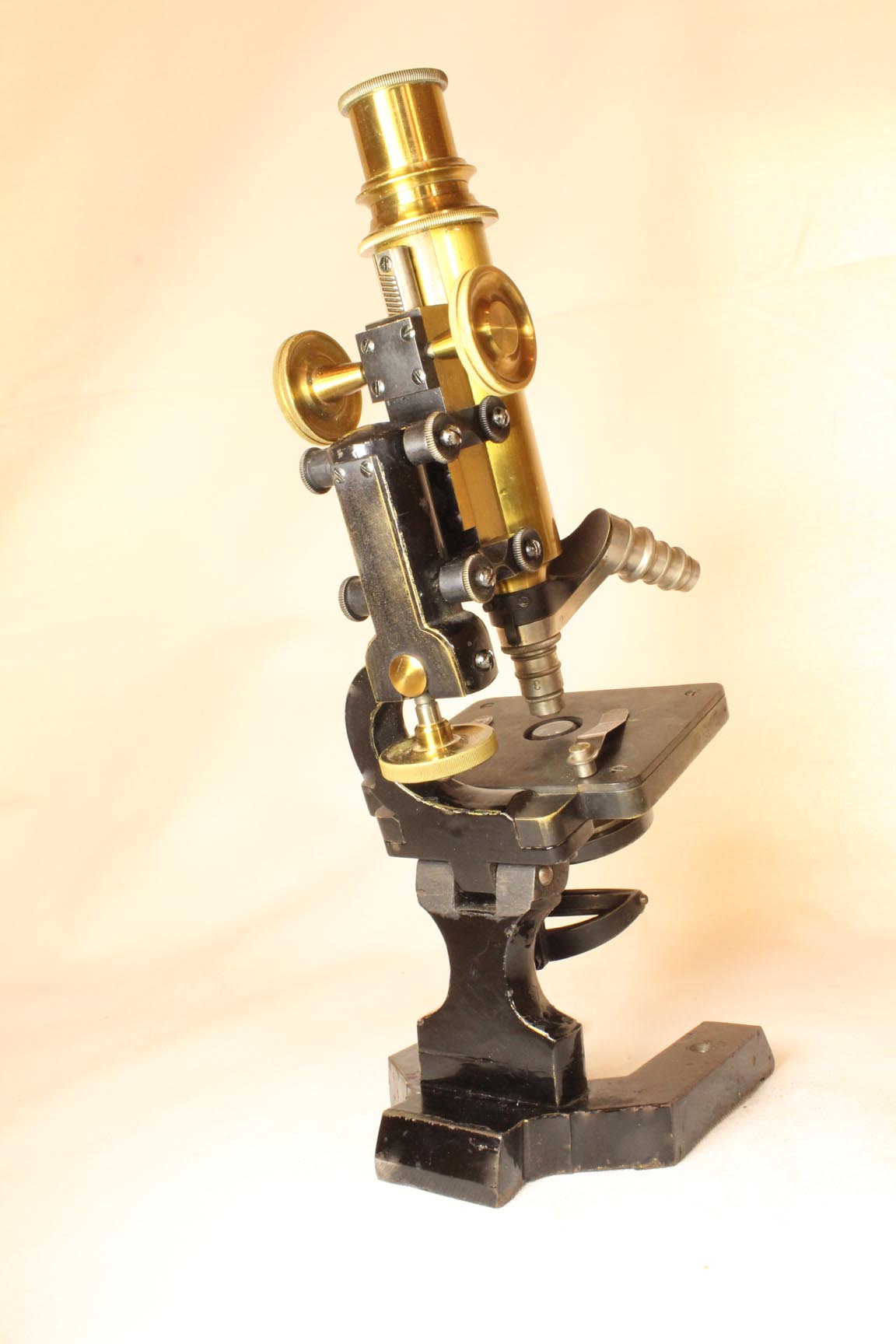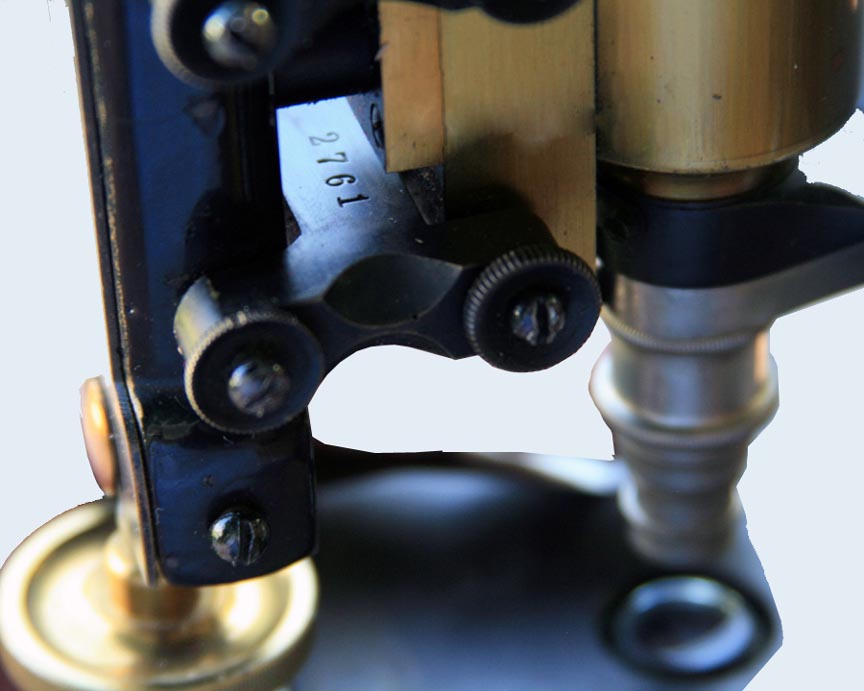
LATERAL C-LIMB MICROSCOPE BY R. KRUGELSTEIN
YEAR: c. 1900
SIGNED: R. KRUGELSTEIN, BERLIN
SERIAL NUMBER: 2761
MODEL: --?--
DESCRIPTION:
 This
microscope arises on an I-shaped pillar from a typical horseshoe-shaped continental foot. The signature
appears on the top plate of the parallel linkage fine focusing
mechanism. The serial number is on the lower plate as shown in the image to the left. This contrasts with the other Krugelstein Microscope in this collection where the serial number is on the top plate and there is no signature. The limb can incline from the vertical to the horizontal.
The substage consists of a cylinder fitted to the underside of the
stage to accept either the supplied Abbe condenser with iris diaphragm, or a
cylindrical fitting that accepts one of three aperture stops (not now present). The distance from the top of the stage is varied simply by pushing or pulling the accessory up or down in the sleeve.
The presence of the lensed condenser with iris makes the use of the
other form of aperture stops unneccessary. The 'lateral-C' limb above the stage allows the fine focus knob to project downward,
acting on the parallel linkage fine focus mechanism above. Coarse focus is by diagonal rack and spiral pinion; this is in contrast to the earlier Krugelstein microscope in this collection which has a straight rack and pinion.
Accessories include the two different
condenser fittings, three eyepieces (numbered 2, 3, and 4), and three original objectives (numbered 3,7, and Oel Ims) on a
triple nosepiece. These objectives, like others supplied by Krugelstein are of smaller diameter than the RMS standard. The brass optical tube is fitted with nickel-plated drawtube.
The gimbaled substage double-sided plane and concave mirror is on a swinging tailpiece, not only allowing oblique illumination, but swinging aside to make removing or adjusting the condenser much easier. The original fruitwood case features red velvet cloth cushions over the wood fittings, and the original magnification card.
There is a compartment in the case under the microscope which is empty.
This
microscope arises on an I-shaped pillar from a typical horseshoe-shaped continental foot. The signature
appears on the top plate of the parallel linkage fine focusing
mechanism. The serial number is on the lower plate as shown in the image to the left. This contrasts with the other Krugelstein Microscope in this collection where the serial number is on the top plate and there is no signature. The limb can incline from the vertical to the horizontal.
The substage consists of a cylinder fitted to the underside of the
stage to accept either the supplied Abbe condenser with iris diaphragm, or a
cylindrical fitting that accepts one of three aperture stops (not now present). The distance from the top of the stage is varied simply by pushing or pulling the accessory up or down in the sleeve.
The presence of the lensed condenser with iris makes the use of the
other form of aperture stops unneccessary. The 'lateral-C' limb above the stage allows the fine focus knob to project downward,
acting on the parallel linkage fine focus mechanism above. Coarse focus is by diagonal rack and spiral pinion; this is in contrast to the earlier Krugelstein microscope in this collection which has a straight rack and pinion.
Accessories include the two different
condenser fittings, three eyepieces (numbered 2, 3, and 4), and three original objectives (numbered 3,7, and Oel Ims) on a
triple nosepiece. These objectives, like others supplied by Krugelstein are of smaller diameter than the RMS standard. The brass optical tube is fitted with nickel-plated drawtube.
The gimbaled substage double-sided plane and concave mirror is on a swinging tailpiece, not only allowing oblique illumination, but swinging aside to make removing or adjusting the condenser much easier. The original fruitwood case features red velvet cloth cushions over the wood fittings, and the original magnification card.
There is a compartment in the case under the microscope which is empty.
HISTORY RELATING TO R KRUGELSTEIN AND FEATURES OF THIS MICROSCOPE
Krugelstein is one of the lesser-known German microscope makers of the late 19th and early 20th century from about 1875 to the early 1900's. Stands by this firm are rather uncommon. There are no Krugelstein microscopes in the Billings Collection, and most private collectors do not seem to have one. Krugelstein microscopes are known for the downward facing fine focus control inside a C-shaped limb above the stage that curves to the side rather than to the back, as in most microscopes.
The downward pointing fine focus is found under the limb above the stage in microscopes by many makers, including Baker (Nelson Model), Sidle (ACME No. 4), and others, but only in Krugelstein models does the limb form a lateral curve above the stage.
The parallel linkage fine focus mechanism was apparently invented by Gundlach and/or the Seiberts when they were all working together; it was used by Seibert for many years after Gundlach left for the United States. This type of fine focus was also used by Leitz in Germany and even by Walter Bulloch in the U.S.A. on the Bastin-Bulloch microscope. In the example by Seibert in this collection, the fine focus knob is under the stage and the pillar is a lateral-facing C., as opposed to the lateral-C shaped limb above the stage found on Krugelstein stands. Many other German makers used the lateral C form of pillar below the stage this way, but apparently only Krugelstein used a lateral C form of Limb above the stage.

 This
microscope arises on an I-shaped pillar from a typical horseshoe-shaped continental foot. The signature
appears on the top plate of the parallel linkage fine focusing
mechanism. The serial number is on the lower plate as shown in the image to the left. This contrasts with the other Krugelstein Microscope in this collection where the serial number is on the top plate and there is no signature. The limb can incline from the vertical to the horizontal.
The substage consists of a cylinder fitted to the underside of the
stage to accept either the supplied Abbe condenser with iris diaphragm, or a
cylindrical fitting that accepts one of three aperture stops (not now present). The distance from the top of the stage is varied simply by pushing or pulling the accessory up or down in the sleeve.
The presence of the lensed condenser with iris makes the use of the
other form of aperture stops unneccessary. The 'lateral-C' limb above the stage allows the fine focus knob to project downward,
acting on the parallel linkage fine focus mechanism above. Coarse focus is by diagonal rack and spiral pinion; this is in contrast to the earlier Krugelstein microscope in this collection which has a straight rack and pinion.
Accessories include the two different
condenser fittings, three eyepieces (numbered 2, 3, and 4), and three original objectives (numbered 3,7, and Oel Ims) on a
triple nosepiece. These objectives, like others supplied by Krugelstein are of smaller diameter than the RMS standard. The brass optical tube is fitted with nickel-plated drawtube.
The gimbaled substage double-sided plane and concave mirror is on a swinging tailpiece, not only allowing oblique illumination, but swinging aside to make removing or adjusting the condenser much easier. The original fruitwood case features red velvet cloth cushions over the wood fittings, and the original magnification card.
There is a compartment in the case under the microscope which is empty.
This
microscope arises on an I-shaped pillar from a typical horseshoe-shaped continental foot. The signature
appears on the top plate of the parallel linkage fine focusing
mechanism. The serial number is on the lower plate as shown in the image to the left. This contrasts with the other Krugelstein Microscope in this collection where the serial number is on the top plate and there is no signature. The limb can incline from the vertical to the horizontal.
The substage consists of a cylinder fitted to the underside of the
stage to accept either the supplied Abbe condenser with iris diaphragm, or a
cylindrical fitting that accepts one of three aperture stops (not now present). The distance from the top of the stage is varied simply by pushing or pulling the accessory up or down in the sleeve.
The presence of the lensed condenser with iris makes the use of the
other form of aperture stops unneccessary. The 'lateral-C' limb above the stage allows the fine focus knob to project downward,
acting on the parallel linkage fine focus mechanism above. Coarse focus is by diagonal rack and spiral pinion; this is in contrast to the earlier Krugelstein microscope in this collection which has a straight rack and pinion.
Accessories include the two different
condenser fittings, three eyepieces (numbered 2, 3, and 4), and three original objectives (numbered 3,7, and Oel Ims) on a
triple nosepiece. These objectives, like others supplied by Krugelstein are of smaller diameter than the RMS standard. The brass optical tube is fitted with nickel-plated drawtube.
The gimbaled substage double-sided plane and concave mirror is on a swinging tailpiece, not only allowing oblique illumination, but swinging aside to make removing or adjusting the condenser much easier. The original fruitwood case features red velvet cloth cushions over the wood fittings, and the original magnification card.
There is a compartment in the case under the microscope which is empty.